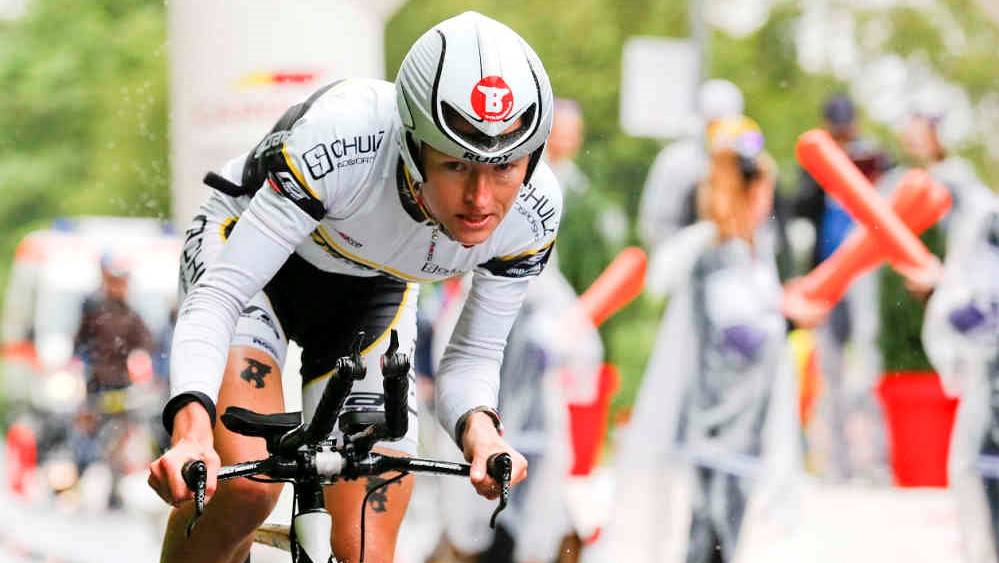Klar, das Radfahren wirkt an sich relativ simpel. Raus aus der Wechselzone, in die Pedale treten und je nach Distanz nach bis zu 180km wieder absteigen. Aber besonders das Radtraining bietet häufig noch viel Verbesserungspotenzial. Hier zeigen wir euch die acht häufigsten Fehler und geben euch Tipps wie ihr sie vermeiden könnt.
Fehler 1 - Kein Helm
Obwohl mittlerweile nur noch wenige Sportler ohne Helm unterwegs sind, sieht man doch hin und wieder noch schwarze Schafe. Da die Ausreden des Gewichts, schlechter Belüftung oder mangelnder Komfort heutzutage aber dank moderner Technik und neuem Material nicht mehr aktuell sind gibt es eigentlich keinen Grund ohne Kopfschutz aufs Rad zu steigen. Falls das als Argument nicht reicht: Im Jahr 2019 gab es über 87.000 Unfälle mit Personenschaden bei denen Fahrradfahrer beteiligt waren. Davon waren pro 1000 Unfällen jeder fünfte mit tödlicher Folge.
triathlon.de Tipp: Falls es zu einem Sturz kam und euer Helm beansprucht wurde, solltet ihr diesen austauschen. Deswegen ist auch von gebraucht gekauften Helmen abzuraten. Da auch das Material verschleißt sollte ein Radhelm auch ohne Sturz alle fünf Jahre ausgetauscht werden
Fehler 2 - Falsches Rad
Obwohl es einen gewissen Spielraum gibt, alles kann man am Rad leider nicht passend machen, wenn die eigentliche Größe nicht passt. Deswegen solltet ihr euch folgende Dinge unbedingt vor dem Kauf überlegen:
Wie willst du dein neues Rad nutzen? Willst du für Ebenen, Radrennen, Berge und Triathlon mit einem Rennrad flexibel sein und dafür die aerodynamischen Nachteile akzeptieren? Oder suchst du einen Triathlon-Boliden, der zwar fürs Zeitfahren ideal ist, aber für Berge unbequem werden kann?
Wenn diese Fragen geklärt sind geht es natürlich noch ins Detail und um die Rahmengröße, da das Rad am besten einstellbar ist, wenn die Größe richtig gewählt ist.
triathlon.de Tipp: Suche dir beim Kauf kompetente Beratung bei einem Fachhändler, da dieser auch häufig Testfahrten anbietet.
Fehler 3 - Falsche Sitzposition
Selbst das teuerste Rad ist nicht effizient, wenn die Sitzposition falsch ist. Diese ist aus aerodynamischer Sicht natürlich am wichtigsten, aber auch andersherum gilt: Die Schnellste Aeroposition ist nicht gut, wenn sie unbequem und ineffektiv ist. Auch unruhiges Fahren, Rücken- und Nackenschmerzen und taube Hände und Füße sind nur ein paar von vielen Nebenwirkungen einer schlechten Position. Auch schlechte Aerodynamik, dadurch verringerte Leistung und oft auch Probleme auf der Laufstrecke können folgen.
triathlon.de Tipp: Bei unserem Bike-Fitting wird das Rad auf den Millimeter genau auf dich und deine Bedürfnisse eingestellt. Dadurch kann auch die bestmögliche Verbindung von Aerodynamik und Komfort auf dem Rad garantiert werden. Allgemein sollte die Position regelmäßig überprüft werden, wenn sich Körperbau und/oder Trainingszustand verändert haben, oder neue Komponenten ans Rad kommen sollen.
Fehler 4 - Material vernachlässigen
Über den Winter in den Keller und im Frühling dann ab auf die Straße mit dem Rad. So sieht es bei vielen Hobby-Athleten aus. Doch häufig kommt es dann - meist am ungünstigsten Streckenabschnitt - zur bösen Überraschung: der klassische platte Reifen. Doch neben Nerven kosten Materialschwächen auch einiges an Fahrsicherheit, da ein nicht gewartetes Rad ein deutliches Sicherheitsrisiko für den Fahrer und andere darstellt.
triathlon.de Tipp: Radschäden sind leicht vermeidbar, wen einmal im Jahr alle Verschleißteile gewartet werden. Möchte man das nicht selbst erledigen sollte es am besten Frühzeitig beim Fachhändler erledigt werden. Zum Radtraining sollte aber auch die optische und funktionelle Überprüfung aller sicherheitsrelevanten Teile dazugehören.
Fehler 5 - Schlechte Technik
Wackeln nach links und rechts, hüpfen im Sattel, die Knie nicht über dem Pedal, oder ein unrunder Tritt - all das sind Anzeichen für schlechte Technik. Dieser Mangel kostet einiges an Kraft und Energie und kann außerdem die Fahrsicherheit stark negativ beeinflussen.
triathlon.de Tipp: Kleinere Schwächen lassen sich ideal im Herbst und Winter auf dem Radtrainer korrigieren und üben. Das Fahren vor dem Spiegel zeigt Position und Technik und mit dem MTB lässt sich das Gleichgewicht und die Geschicklichkeit schulen.
Fehler 6 - Gleichbleibende Frequenz
Häufig hat man im Training eine eigene Lieblings-Frequenz. Entweder langsam und kraftbetont, hochtourig und schnell oder irgendwo dazwischen. Und obwohl natürlich auch der überwiegende Teil des Wettkampfs vermutlich in diesem Bereich stattfinden wird, sollten auch andere Fahrtechniken, bis hin zum gegenteiligen Extrem beherrscht werden. Dadurch können sich die Fähigkeiten (ähnlich wie beim Krafttraining) weiterentwickeln, da die unterschiedlichen motorischen Reize auch unterschiedliche Reize an den Muskel weitergeben.
triathlon.de Tipp: Baut im Winter in euer Training ruhig Abschnitte mit maximaler Frequenz ein und im Frühjahr lohnt es sich, mal einen Anstieg im hohen Gang und mal mit hoher Frequenz zu fahren.
Fehler 7 - Keine Abwechslung bei der Intensität
Abwechslungsreiche Reize sind sportartübergreifend wichtig. Aber vor allem bei Langdistanz-Athleten sieht man häufig stundenlanges monotones Fahren. Anfangs erhält man dadurch zwar eine gute Grundlage, aber auf lange Sicht kommt es schnell zur Stagnation. Andere dagegen versuchen bei ihren Ausfahrten einfach nur am Ende wieder einen guten Schnitt am Tracker stehen zu sehen und achten dabei gar nicht auf ihre Herzfrequenz oder ähnliches. Das braucht dann besonders lange Regenerationszeiten und aufgrund der fehlenden Grundlage kann man keine stabile Form ausbilden.
triathlon.de Tipp: Zu Beginn der Trainingssaison eine gute Grundlage auf- und dann vermehrt intensive Einheiten einbauen.
Fehler 8 - Mangelnde Kenntnis der Regeln beim Fahren in der Gruppe
Obwohl Triathleten Einzelkämpfer sind kommt es doch hin und wieder zum Pulk auf der Straße. Hier sind die wichtigsten Stichpunkte, damit es in diesen Situationen nicht zu Problemen kommt:
- Beherrsche das Fahren in Zweierreihe
- Signale müssen nach hinten weitergegeben werden
- Gleichmäßiges Tempo in der Führung
- Abstand zum Vordermann richtig einschätzen und dosieren
- Sei aufmerksam und bremsbereit
triathlon.de Tipp: Fahren in der Gruppe erfordert zwar etwas Übung, macht aber Spaß wenn man sich dann gegenseitig motivieren und unterstützen kann!




















